
By Dan Duncan – Retired, Pinnacle Rarities ……
The 59 distinct designs of the silver and gold classic commemoratives are often collected by theme. The bald eagle depictions are some of the most interesting and popular of these sets. From Robert Scot’s early Mint small eagle to the majestic in-flight version that graces the newest Silver Eagle bullion, our national bird has been portrayed numismatically with a number of artistic interpretations. This is done nowhere more diverse than in the varied imagery utilized in the classic commemoratives. With the designers allowed a certain latitude, the depiction of the eagle in the commemorative series is arguably the most artistic in all of U.S. numismatics.
Here is a look at these 11 examples with emphasis on our nation’s classic bird.
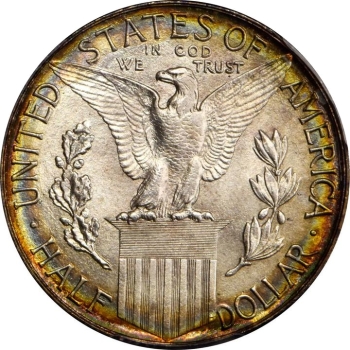 Much of the circulating silver coinage at the turn of the 20th century had a heraldic reverse, but none of the first three silver commemoratives featured an eagle. After a 10-year hiatus from the earliest gold and silver commemoratives, legislation was enacted that provided for five different coins for distribution at the Panama Pacific Exposition of 1915. The group collectively was the first collaborative work between the Department of the Treasury and the Commission of Fine Arts (CFA) for a commemorative issue. A couple of bills were initially drafted, with the final act authorizing a silver half dollar, a gold dollar, a $2.50 quarter eagle gold coin, and the magnificent round and octagonal $50 designs.
Much of the circulating silver coinage at the turn of the 20th century had a heraldic reverse, but none of the first three silver commemoratives featured an eagle. After a 10-year hiatus from the earliest gold and silver commemoratives, legislation was enacted that provided for five different coins for distribution at the Panama Pacific Exposition of 1915. The group collectively was the first collaborative work between the Department of the Treasury and the Commission of Fine Arts (CFA) for a commemorative issue. A couple of bills were initially drafted, with the final act authorizing a silver half dollar, a gold dollar, a $2.50 quarter eagle gold coin, and the magnificent round and octagonal $50 designs. 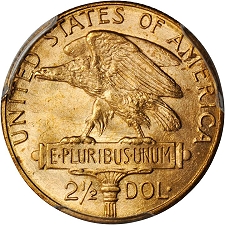 The commission worked with several artists in preparation of designs, but ultimately only the two fifties and the gold dollar came from artists recommended by the CFA. The $2.5 and the half dollar were created by Charles Barber and George T. Morgan. Both of these designs use a rendering of the nation’s bird. With the time constraints pressed upon the two engravers, Barber and Morgan reused previous designs to create their contributions.
The commission worked with several artists in preparation of designs, but ultimately only the two fifties and the gold dollar came from artists recommended by the CFA. The $2.5 and the half dollar were created by Charles Barber and George T. Morgan. Both of these designs use a rendering of the nation’s bird. With the time constraints pressed upon the two engravers, Barber and Morgan reused previous designs to create their contributions.
The quarter-eagle commemorative reverse is an adaptation of Morgan’s half dollar patterns and his “School Girl” patterns. They have an eagle facing left perched on a scroll inscribed with “E Pluribus Unum”.
Absent are the arrows and olive branches. These were likely omitted to not indicate a political posture with the advent of World War I in Europe, a conflict that the United States had yet to enter. The reverse of the half dollar was also engraved by Morgan. This eagle is a smaller similar version of his dollar reverse tilted slightly right. Again absent were the arrows and olive branch. He perches this eagle on a simple shield with stripes and bars represented by perpendicular fine lines. The concept of the bird atop an escutcheon was used previously by Morgan on a proposed $100 gold coin from 1876 but was never produced.
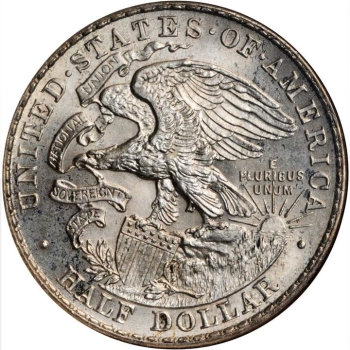 George Morgan again worked on a classic commemorative in 1918 with his obverse portrayal of a solemn and beardless Abraham Lincoln that graces the Illinois Centennial. At this point, Morgan was in his early 70s and left the reverse work to his assistant engraver John R. Sinnock. This eagle reverse is a rendering of the Illinois State Seal. The image features a walking eagle facing left with shield in one talon and an olive branch on the ground below. In the beak of the eagle is a ribbon with the words “STATE SOVEREIGNTY, NATIONAL UNION.” The original models met with some resistance from the Treasury due to the lack of the inscription E PLUBUS UNUM, which on previous coinage is found in the ribbon and the word LIBERTY. They were added to the fields and the half dollar went into production in August of 1918.
George Morgan again worked on a classic commemorative in 1918 with his obverse portrayal of a solemn and beardless Abraham Lincoln that graces the Illinois Centennial. At this point, Morgan was in his early 70s and left the reverse work to his assistant engraver John R. Sinnock. This eagle reverse is a rendering of the Illinois State Seal. The image features a walking eagle facing left with shield in one talon and an olive branch on the ground below. In the beak of the eagle is a ribbon with the words “STATE SOVEREIGNTY, NATIONAL UNION.” The original models met with some resistance from the Treasury due to the lack of the inscription E PLUBUS UNUM, which on previous coinage is found in the ribbon and the word LIBERTY. They were added to the fields and the half dollar went into production in August of 1918.
 The 1921 Alabama Centennial and the 2X2 variety is the next classic commemorative to use the eagle.
The 1921 Alabama Centennial and the 2X2 variety is the next classic commemorative to use the eagle.
Both obverse and reverse were designed by Laura Gardin Fraser at the suggestion of her husband James Earl Fraser, who served as the sculptor member of the CFA. The reverse eagle motif, like the Illinois commemorative before, is an interpretation of the commemorated state’s official seal. The eagle appears in higher relief than previous Mint issues and is in stride facing left with arrows in its talons. A shield of stripes and bars is positioned three-dimensionally underneath. In the beak is a ribbon with the words “HERE WE REST”.
Fraser’s work here is considered by many as one of the best eagle depictions in all of U.S. numismatics. The issue is controversial for its belated release and for the use of the likeness of a living individual. The obverse shows a comingled bust of the then-sitting governor T.E. Kilby and the state’s first governor William Wyatt Bibb.
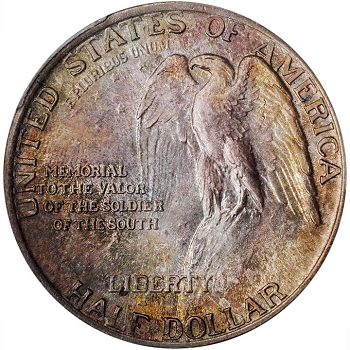 The next classic U.S. commemorative coin to feature an eagle is the Stone Mountain Memorial half dollar and it, too, is not without controversy. Gutzon Borglum, a celebrated artist in his time, met with much criticism for his original designs for the coin. Legislation for the commemorative passed without issue and was originally intended to fund the creation of a monument to not only the Confederate soldiers but their inspiration of the men and women that fought in all the wars that followed. It also included a memorial to the recently deceased President Warren G. Harding, under whose administration work on the Georgian bluff had begun.
The next classic U.S. commemorative coin to feature an eagle is the Stone Mountain Memorial half dollar and it, too, is not without controversy. Gutzon Borglum, a celebrated artist in his time, met with much criticism for his original designs for the coin. Legislation for the commemorative passed without issue and was originally intended to fund the creation of a monument to not only the Confederate soldiers but their inspiration of the men and women that fought in all the wars that followed. It also included a memorial to the recently deceased President Warren G. Harding, under whose administration work on the Georgian bluff had begun.
Borglum’s initial models were soundly rejected by the Commission of Fine Arts and subsequent changes were not well received. The final renderings were only reluctantly accepted. His reverse features a stoic eagle perched on a mountain cliff overlooking an inscription with a scattering of 35 stars weakly impressed in the fields. Originally the inscription was to say, “COMMEMORATING THE VALOR OF THE SOLDIER OF THE SOUTH. STONE MOUNTAIN, GEORGIA. AND IN MEMORY OF WARREN G. HARDING 1924”. The inclusion of the recently deceased President was rejected by the White House. His name and the date 1924 were replaced with the word LIBERTY.
Borglum blamed his repeated alterations and dealings with the CFA as an excuse for falling behind on his duties at the actual monument. He was discharged by the Confederate Monumental Association prior to the release of the commemorative. He went on to create Mount Rushmore, a project he began during his work on the Stone Mountain Memorial and associated coinage. The Stone Mountain Memorial was not completed until 1970.
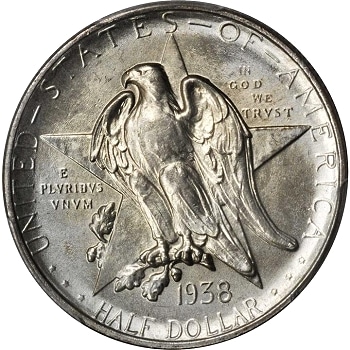 The Texas Centennial is one of the most popular issues in the classic commemorative series. Approved three years prior to the actual centennial, the issue was produced annually from 1934 until 1938. Funds from the coin’s sale were to facilitate the celebration and profits to go toward the construction of a memorial building.
The Texas Centennial is one of the most popular issues in the classic commemorative series. Approved three years prior to the actual centennial, the issue was produced annually from 1934 until 1938. Funds from the coin’s sale were to facilitate the celebration and profits to go toward the construction of a memorial building.
Models for the issue were prepared by Pompeo Coppini. The artist had created a number of statues and monuments across the state over the previous three decades. His initial designs were heavily criticized for their “vulture-like” eagle and complicated reverse. Overall, Coppini’s concept remained, but only after some improvements. His revamped eagle was more erect and dignified. His designs were approved despite the reverse remaining quite intricate. It was panned by the Treasury as a seeming attempt at including the entirety of Texas history. Coppini went on to design the Hall of State that was erected for the state’s own centennial celebration and remains to this day as part of the Texas State Fair Grounds.
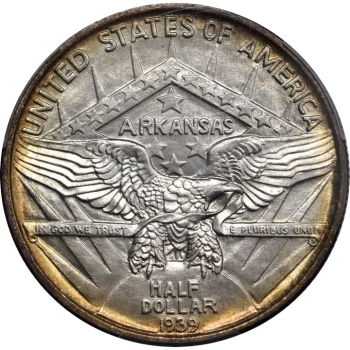 In 1934, another state gained approval for a multiyear commemorative coin to fund their gala associated with their centennial. The Arkansas Centennial Commission hosted a competition and hired local commercial artist Edward E. Burr. His original sketches were declined by the CFA due to his lack of experience in the medallic arts. The Arkansas contingency insisted on their choice of artist. Burr assented to alterations but insisted on the significance of his reverse elements. The use of the Arkansas flag symbolized the history of French, Spanish, and Confederate rule. The eagle represented the state now being under the protection of the United States.
In 1934, another state gained approval for a multiyear commemorative coin to fund their gala associated with their centennial. The Arkansas Centennial Commission hosted a competition and hired local commercial artist Edward E. Burr. His original sketches were declined by the CFA due to his lack of experience in the medallic arts. The Arkansas contingency insisted on their choice of artist. Burr assented to alterations but insisted on the significance of his reverse elements. The use of the Arkansas flag symbolized the history of French, Spanish, and Confederate rule. The eagle represented the state now being under the protection of the United States.
His sketches were reworked by CFA sculptor member Lee Lawrie, refined by Burr, and ultimately modeled by Emily Bates another Arkansas artist. Ultimately, the obverse chosen shows a Native American and Lady Liberty in profile, having been portrayed originally looking forward. The final reverse motif was basically the same as Burr’s original design, albeit with a slightly less “commercial” eagle rendering.
The eagle is perched on the sun with rays extending behind the central devices. A ribbon extends from the beak stretching across the coin bearing the words IN GOD WE TRUST and E PLURIBUS UNUM. Behind is the central state flag design with ARKANSAS appearing above the outstretched wings.
In 1936 both the Texas and the Arkansas Centennial Commissions sought approval for additional coinage. Texas was declined. Arkansas received one more year of issue with a revised obverse and Burr’s reverse eagle.
Originally the Arkansas Commission considered the likeness of Spanish explorer Ferdinand De Soto. Ultimately, however, Senator Joseph T. Robinson consented to the use of this likeness and the Robinson-Arkansas was created, another example of a living individual used on a coin. This obverse was created by Henry Kreis, whose works can be seen on a couple of the period commemoratives.
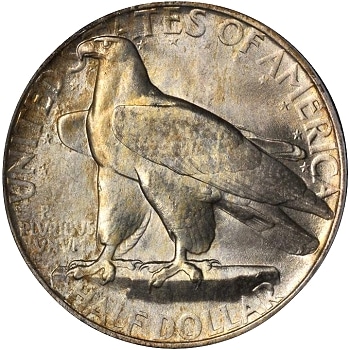 One of Kreis’ other commemorative works is the Connecticut Tercentenary. The coin commemorated the 300th anniversary of the colony’s charter. His stylized reverse eagle is reminiscent of Saint-Gauden’s $10 eagle. The original model for the eagle was considered too sleek, with smaller talons and head. Kreis strengthen his design and the new models flew through. The final reverse is prized, but the Charter Oak obverse motif steals the show. This commemorative is considered by many as one of the most appealing in the series.
One of Kreis’ other commemorative works is the Connecticut Tercentenary. The coin commemorated the 300th anniversary of the colony’s charter. His stylized reverse eagle is reminiscent of Saint-Gauden’s $10 eagle. The original model for the eagle was considered too sleek, with smaller talons and head. Kreis strengthen his design and the new models flew through. The final reverse is prized, but the Charter Oak obverse motif steals the show. This commemorative is considered by many as one of the most appealing in the series.
For as much praise as this Connecticut half receives, his other Connecticut half, the Bridgeport, gathers criticism. The negative critiques center on both obverse content and the Art Deco eagle reverse.  In 1936, the Bridgeport, CT Centennial was authorized to celebrate the 100th year of the city. The obverse portrait features P.T. Barnum, whose celebrity doesn’t quite stand the test of time. Today he is mainly associated with his circus and is considered by many a charlatan. But for the city, Barnum is beyond reproach. His leadership, philanthropy, material contributions to local industry and general showmanship makes him one of Bridgeport’s favorite son – a sentiment lost outside of the region. The eagle is an Art Deco version of Kreis’ already stylized eagle from his previous work. The result is a smooth central device with angular wings lacking significant feather definition.
In 1936, the Bridgeport, CT Centennial was authorized to celebrate the 100th year of the city. The obverse portrait features P.T. Barnum, whose celebrity doesn’t quite stand the test of time. Today he is mainly associated with his circus and is considered by many a charlatan. But for the city, Barnum is beyond reproach. His leadership, philanthropy, material contributions to local industry and general showmanship makes him one of Bridgeport’s favorite son – a sentiment lost outside of the region. The eagle is an Art Deco version of Kreis’ already stylized eagle from his previous work. The result is a smooth central device with angular wings lacking significant feather definition.
This is probably the most polarizing eagles in U.S. numismatics, though it does stand as a representation of the art movement of its time. Collectors either love it or hate it.
 The Iowa Centennial is the last eagle motif of this series. The obverse alludes to the Iowa flag with an eagle in flight holding a ribbon with the motto “OUR LIBERTIES WE PRIZE AND OUR RIGHTS WE WILL MAINTAIN”. Designed by Adam Pietz, the drawings of the eagle that were originally submitted weren’t openly embraced, but with little time for changes they were approved with just a small change – the addition of talons. Above the hunched eagle are 29 stars representing Iowa’s place as the 29th state to enter the Union. The reverse offers a portrait of the Old Stone Capital located in Iowa City. The building now is part of the Iowa State University campus, and was the last capital prior to statehood. A portion of the mintage was held back and 500 were released in 1996, and another 500 are scheduled for release in 2046.
The Iowa Centennial is the last eagle motif of this series. The obverse alludes to the Iowa flag with an eagle in flight holding a ribbon with the motto “OUR LIBERTIES WE PRIZE AND OUR RIGHTS WE WILL MAINTAIN”. Designed by Adam Pietz, the drawings of the eagle that were originally submitted weren’t openly embraced, but with little time for changes they were approved with just a small change – the addition of talons. Above the hunched eagle are 29 stars representing Iowa’s place as the 29th state to enter the Union. The reverse offers a portrait of the Old Stone Capital located in Iowa City. The building now is part of the Iowa State University campus, and was the last capital prior to statehood. A portion of the mintage was held back and 500 were released in 1996, and another 500 are scheduled for release in 2046.
The eagle remains a popular motif for modern U.S. coinage. The majestic bird is portrayed on the popular bullion coins struck in both silver and gold and on many of the modern commemoratives coming out of the mint today. Collecting rare coins for their imagery is a common practice, and the classic commemoratives are often assembled in sets for their unique motifs. Popular thematic collections are regional sets, nautical themes, Art Deco designs, the Civil War, and of course the eagles.
The series is one of our favorites and we invite you to explore the 58 individual designs and enjoy their unique vignettes and their colorful glimpses into the 20th century.




